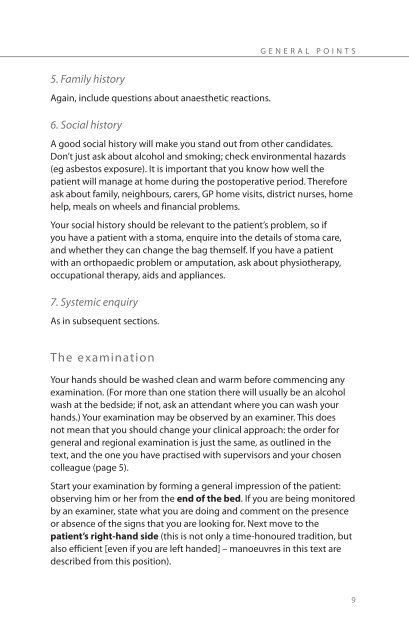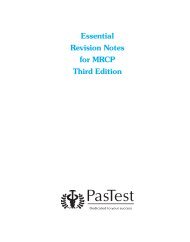SURGICAL FINALS Passing the Clinical - PasTest
SURGICAL FINALS Passing the Clinical - PasTest
SURGICAL FINALS Passing the Clinical - PasTest
- No tags were found...
Create successful ePaper yourself
Turn your PDF publications into a flip-book with our unique Google optimized e-Paper software.
G E N E R A L P O I N T S5. Family historyAgain, include questions about anaes<strong>the</strong>tic reactions.6. Social historyA good social history will make you stand out from o<strong>the</strong>r candidates.Don’t just ask about alcohol and smoking; check environmental hazards(eg asbestos exposure). It is important that you know how well <strong>the</strong>patient will manage at home during <strong>the</strong> postoperative period. Thereforeask about family, neighbours, carers, GP home visits, district nurses, homehelp, meals on wheels and financial problems.Your social history should be relevant to <strong>the</strong> patient’s problem, so ifyou have a patient with a stoma, enquire into <strong>the</strong> details of stoma care,and whe<strong>the</strong>r <strong>the</strong>y can change <strong>the</strong> bag <strong>the</strong>mself. If you have a patientwith an orthopaedic problem or amputation, ask about physio<strong>the</strong>rapy,occupational <strong>the</strong>rapy, aids and appliances.7. Systemic enquiryAs in subsequent sections.The examinationYour hands should be washed clean and warm before commencing anyexamination. (For more than one station <strong>the</strong>re will usually be an alcoholwash at <strong>the</strong> bedside; if not, ask an attendant where you can wash yourhands.) Your examination may be observed by an examiner. This doesnot mean that you should change your clinical approach: <strong>the</strong> order forgeneral and regional examination is just <strong>the</strong> same, as outlined in <strong>the</strong>text, and <strong>the</strong> one you have practised with supervisors and your chosencolleague (page 5).Start your examination by forming a general impression of <strong>the</strong> patient:observing him or her from <strong>the</strong> end of <strong>the</strong> bed. If you are being monitoredby an examiner, state what you are doing and comment on <strong>the</strong> presenceor absence of <strong>the</strong> signs that you are looking for. Next move to <strong>the</strong>patient’s right-hand side (this is not only a time-honoured tradition, butalso efficient [even if you are left handed] – manoeuvres in this text aredescribed from this position).9
















